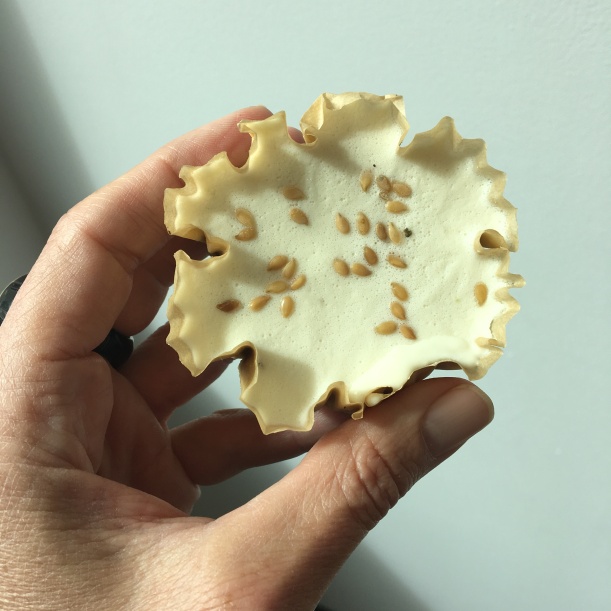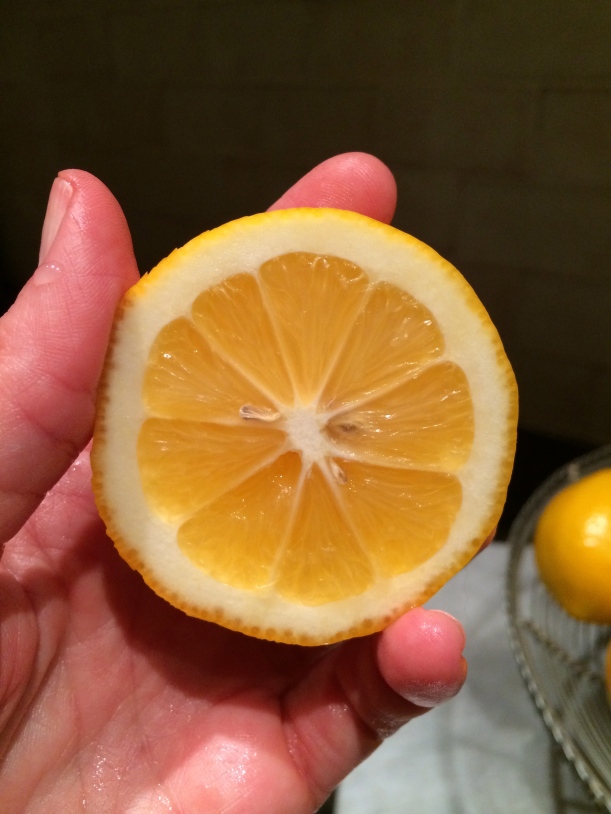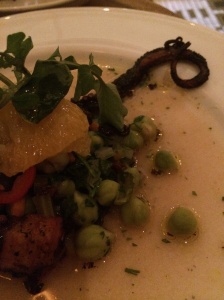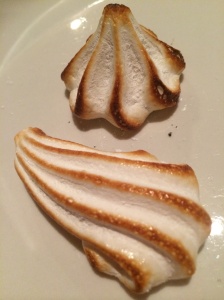I’ve found the most charming spot in my new neighborhood in Albuquerque. Farmacy occupies a little house in the Sawmill district, anchoring the neighborhood with a gracious outdoor patio and a sunny space for breakfast and lunch. The place opened about a month ago by an intrepid young entrepreneurial hipster from Austin. He is efficient and charming, and is off to a promising start. I usually just stop in for coffee on my way to work, but this morning I’m indulging in a weekend breakfast. I devour a crispy, golden empanada, still warm, stuffed with roasted acorn squash, onions and bacon. This place is a little corner of urban comfort. I think Albuquerque is turning a corner.
Author Archives: John Charlotte
Vegan Joy

I’ve only recently met a true vegan, and it has been an education. She is my colleague, so I see her pretty much daily. She holds to a strict diet of vegetables, grains, legumes and such–alcohol sure, but absolutely no dairy or animal protein, ever. She has cheekbones that suggest deprivation, but this vegan attributes her arresting bone structure to her ancestry, a tough genetic pool that carved out food sources from an icy landscape in Finnish Lapland. Despite the rigor of her strict vegan regimen, this one finds real joy in food. One morning she gestures me over to a small cooler she has brought in to the workshop. She opens the lid to reveal a stash of miniature key lime pies, each nestled in brown paper. “Take one” she whispers, letting me in early on the bounty she made for another colleague’s birthday.
The key lime dessert is chilled, deliberately so to preserve the integrity of the coconut oil. It is sweet and creamy, infused with a tangy, crisp bite of citrus. The crust challenges the concept of vegan, but then what do I know about the wonders of Earth Butter. The filling is concocted from soaked cashews, coconut oil, coconut cream, lime juice, zest, and powdered sugar blended together. A few lightly toasted sesame seeds punctuate the delicate yellow surface.
I have new respect for vegan ingenuity and indulgence.
The PI Project
It’s the beginning of the fall season in ABQ.
I’m among a lucky group experiencing a performance piece that includes a superb dinner. Jessamyn Lovell, a New Mexico artist who is pursuing a private investigator license, weaves her hunting instincts in with a unique kind of visual surveillance. Tonight she is performing a piece at Central Features Contemporary Art, titled The PI Project, and we are the subjects. I’m seated along with 30 other diners, wearing a blindfold, and directed to bring a fork to my lips and imagine what might be waiting there. It is a single bite of cantaloupe, brightened with basil, cracked pepper and honey. A kind of instant camaraderie forms, all of us tasting with great attentiveness from behind our black blindfold.
Lovell has laid out every aspect of the the evening, in collaboration with a local consortium of growers and culinary artisans, Dig & Serve, who designed the dining experience. As we arrive, we are processed by masked attendants, photographed, and presented with a sleek dossier, containing the blindfold and a folio. The folio, we later discover, contains a Polaroid–a snapshot of our own front door. Seems all of us were briefly “persons of interest,” with Jessamyn scouting out where we live and presenting us now with the evidence.
The dinner is set up in the gallery, a single table stretches the length of the space. The table is set with white linens and clusters of votive candles. There is a somber, slightly ominous tone, that prompts nervous laughter, and I think of Eyes Wide Shut at times. We yield to a kind of surveillance throughout the evening. At one point the crew of silent, masked attendants presents each diner with a snapshot of themselves taken earlier in the evening, when we were all instructed to put on our blind-folds. With this kind of heightened choreography, every course brings an element of surprise, and I think in the process, our senses are sharpened. We become more observant while under surveillance; and perhaps this is the point, honing our perception by depriving us briefly of the fundamental freedom of sight.
The meal begins with a spicy gazpacho, a tangy blend of watermelon, tomatoes, peppers, and jalapeño, laced with cilantro and lime. Next up is a plate of grilled summer vegetables, a construction of zucchini, okra, and eggplant on a swirl of poblano cream sauce, sprinkled with red pomegranate seeds. With each course a new wine appears. I have the presence to make a snap of one of the bottles, a deep red Diavolo “Devil” from Vivac Winery of Dixon, New Mexico. All of the wines, ranging from a sparkling wine at the outset of the evening, to a Tempranillo, are from this northern New Mexico winery. The main course is a spectacular grilled steak, paired with a luscious corn polenta, and grilled shishito peppers. A blackened grilled peach, smoky and sweet, balances out the plate.
The artist has been silent this entire time, circulating in a humorous PI get-up of a trench and dark glasses. But as the dinner winds down she begins to speak about her process, and the intersection of PI work and her own documentary practice. The dinner concludes with a surprising savory dessert–an heirloom tomato ice cream, seasoned with Thai basil simple syrup, whipped creme freche, and a scattering of purple Thai basil flowers. A paper-thin candied tomato slice garnishes the golden dessert. It’s an astonishing finish to the meal. Lastly, as final remarks are made by the artist and the gallery owner, a spicy nightcap is served in delicate glasses: a cold brew coffee splashed with tequila, vermouth Bianca, a swirl of chocolate, sea salt, pepper, ancho chile, and cinnamon. The glasses glow deep red in the ebbing candlelight.
Flesh of a Pummelo
Flesh of a Pummelo
I’m at Trader Joe’s on a post-work shopping jag. There is a full moon high in the sky, and headlines about five planets lining up. In the produce section I’m taken in by a pile of bright green citrus called Pummelos. They are startling in a way, a tropical haul of enormous green fruit, parked here in Albuquerque under fluorescent lights. I toss one in my basket, amused by the loopy name as much as the dense volume of the thing.
The next morning I peel it with a sharp paring knife. It’s not a simple task. The skin is very thick, course and white beneath the leathery exterior, and the process of releasing the fruit from the heavy fibrous membrane yields an amazing pile of detritus for the compost. It has the structure of a grapefruit, and a similar delicate pink color, but none of the juiciness. I wonder if it is a heavier, duller relation to the sassy grapefruit, or if this citrus just had a tough journey. I present a bowl of segmented fruit to M and we have it with strong French press coffee and toast. He loves tough green fruit and despises a mess, so he’s completely taken with this dull, slightly sweet fruit. It’s not nearly as bright or sharp as a grapefruit, but then it’s probably an unfair comparison. Grapefruit seemed fairly exotic when I was growing up, packaged as a winter fruit from far away. I can remember special slender serrated spoons for grapefruit, and I probably loved the spoons as much as the citrus. This pummelo reminds me of that breakfast table in Missouri decades ago, when tartness was an experience, bright sunlight a luxury, and the world seemed somehow more vast and unknowable.
Turns out there is another reason to eat pummelos this time of year, aside from the novelty. The Chinese New Year celebration includes the pummelo, as it is thought to bring good luck, prosperity and status. Maybe it’s because the Cantonese phrase for pummelo sounds similar to the words for prosperity and status, or so I hear; I think the green fruit is simply joyous, a lumpy lawn ball to be consumed.
Fall Harvest

It is the weekend before Thanksgiving, and the fall season has not yet tipped towards distraction and gluttony. M and I are dining at a new friend’s house in the foothills of Santa Fe. We are the interlopers here among a close-knit group of friends, and I bring locally produced Kakawa chocolates as an offering. Our host, sipping a glass of wine and wearing festive brick red corduroys, meets us at the curb as we arrive. I find an easy alliance with these kind and witty Midwesterners, all of whom are unbelievably, from Kansas. In Boston, I could usually bring conversation to a dead halt if I mentioned I’d grown up in Missouri and went to school at the University of Kansas; but these folks know the geography and the character of the middle part of the country, and there is no need to explain myself. We have, all of us, migrated here with great purpose.
The news of the Paris terrorist attacks has just broken, and under the bright black sky of Santa Fe we struggle to comprehend the violence and the consequences. There are six of us around the table, sharing in an elegant dinner served with great warmth and ease. The hostess has a kind of stealth delivery, slipping away while the conversation is humming along and reappearing silently with the next course. No struggle, no fuss.
“These apples were harvested four hours ago,” says our host from the head of the table, as we dig into an arugula salad punctuated with pine nuts and delicate apple slices. He gestures to the yard and we realize that the apples were harvested from his own trees. I’m bitter that my fruit trees just a few miles away in Galisteo did not produce any fruit this year, all the blossoms zapped by a late frost. After the salad plates are cleared an aromatic pork tenderloin arrives on the table, served with a sweet cherry sauce deepened with balsamic vinegar and port. Its sweet and resonant flavor is the perfect compliment, and we all rave about it. The deep red sauce pools on my plate, amplifying the color of the red china pattern. I begin to recognize the depth of the curating here, with each course and its presentation executed with a flawless visual and gastronomic pairing. A Justin Cabernet Sauvignon from Paso Robles rounds out the deep red flavors, and it flows freely as the stories of this variety being transported across state lines in great quantity for a family wedding makes us all feel a bit clandestine in sharing it.
For the final course, our hostess disappears once again to the kitchen and returns with a magical Lemon Souffle Pudding Cake served in smart individual ramekins. Apparently she had slipped away to bake the dessert while we were blissfully eating, folding together the whipped egg whites and sugar with the bright lemon zest. The pale yellow pudding is dusted with powdered sugar and garnished with plump blackberries. As we exclaim over the lemon dessert our hostess admits it was produced from her own Meyer Lemon tree, a fragrant plant that lives outside in the summer and inside during the winter months. Harvesting on a small scale, for the simple pleasure of feeding family and friends. On this dark night the gathering brings comfort and rootedness.
Untitled, at Whitney Museum of Art, New York
Eating alone without the company of a working phone requires some composure. My mobile died sometime during the evening hour viewing of the Frank Stella exhibition at the Whitney. I decide to pop in to the crowded restaurant on the ground floor on a Saturday night because I feel I must experience this elegant space while I’m in town. I stand somewhat awkwardly near the door until a seat at the bar opens up. Waiters wearing smart grey aprons trimmed in red attend to the diners. Robert Indiana’s electric EAT sign illuminates the wall above the bar, linking the permanent collection to the dining experience. If they’d shown his iconic EAT/DIE, it would have been even better, but that may have been off-putting to the other diners.
I wrap my hand around an ample glass of Pinot Noir, relieved to be rescued from the sidelines and now seated in a Bertolla basket chair. A woman next to me places a luxuriant leather clutch on the bar. I recognize this sleek handbag as more than a possession, but an obligation of sorts, a responsibility to sustain a certain quality of life. It’s a kind of shared community of capitalism that keeps this city humming.
The bartender is a striking black man with a kind, intelligent face. I am able to catch his attention with eye contact alone and he comes over to explain the menu. I hear his subtext that the first few plates listed are immediate and you’ll be out quickly, and the plates further down the list are more involved. I order the lamb meatballs from the quick plates and the Chicory Caesar salad from the assortment of raw plates, partly out of curiosity of how this classic might be represented here.
A server places a folded linen napkin in front of me, a fabric lush enough for a tailored jacket. A single warm artisanal roll is served, swathed in a napkin and presented in a wooden box. Alongside the box a small stone plate is presented with a schemer of delicate salted butter and a small wooden knife. The whole presentation could be imagined in a vitrine in the gallery.
The lamb meatballs arrive in a small porcelain bowl, a cluster of four perfectly round bites awash in a rich spicy Guajillo chile sauce, sprinkled with crushed peanuts. I eat somewhat guiltily as a woman seated next to me inquires anxiously if a particular dish is prepared with any nuts. When I finish the meatballs I mourn the sacrifice of the sauce, and try to discretely scoop up a few more tastes with my fork.
A new fork and knife arrive in advance of the next plate, the Chickory Caeser. The plates are served with a discrete murmur from the server, articulating each dish like an impressive provenance. It is the most perfect assortment of bitter red and lush green lettuces I think I’ve ever tasted, and I imagine the Untitled staff at a nearby farmer’s market, selecting the produce by hand that morning. The Ahi Amarillo dressing brings a yellow verve to the heirloom lettuces, infused with the bright Peruvian chile pepper.
Somehow this abbreviated dinner seems significant, like an extension of the Renzo Piano designed museum space. It is a meal served up like a brilliantly layered, curated experience, one that is tasted more than consumed. Fortified for the cab ride back uptown, the city looks to me more contented at this hour.
Metropole Redux, 21c Museum Hotel, Cincinnati
I’ll admit there is something absurd about ordering octopus in Cincinnati, but that’s what I’m doing. The hipster waiter at Metropole lights up when I ask him how it is prepared, and I sense it is special. I’m enjoying one of those solo midweek business trip dinners, and I am craving a meal worthy of solitude. I’ve decided to give the unfamiliar a try–there might be greatness here.
A single tentacle is coiled elegantly on my dinner plate. It is accompanied by fresh green garbanzo beans, a modest scattering of hot peppers, a slice of citrus, currants, and a tangle of peppery watercress. Chef Jared Bennett prepares the octopus with a long 3 hour braising and then a quick sear over high heat. The result is a firm texture and a smoky, delectable taste with a slight bit of heat. The presentation does not mask that this is indeed an octopus tendril, likely a baby octopus, and I feel as though this creature deserves a blessing of some kind. I eat every bite, and take in its strength. This mollusk was swimming the warm waters off Vietnam when some fisherman grabbed him. It’s grotesque, I know, to ingest something from the other side of the world. But this is the time we live in. And in my current life I am admittedly contributing a high carbon footprint, there’s no way around that. So I decide to see it as another experience, a way of supporting an ambitious culinary idea.
This little restaurant on the ground floor of 21c Museum Hotel is where I started this blog more than a year ago, and it feels like a bit of an occasion to be back here, for me anyway. It seems as though I’ve traveled nearly as many miles as the octopus since then.
A & J King Artisan Bakers, Salem MA
I am leaving Salem in painfully slow measures. It has been more than two months since I moved out of my condo of 10 years, but I’m still here. And for the short term anyway, I’m living an increasingly nomadic life. My shoes are becoming more and more sensible, and my handbag ridiculously heavy. When I’m in Boston for work I stay with my friends Dan and Joe, alternating between them, but now Dan too has pulled up stakes and moved to a new city.
The movers are coming next week to pack him up, so this is the end of my house squatting in Dan’s sweet McIntyre District place. His complex scent of products, cologne, and candles still hangs in the air, but he has cleared out. It is like a mini retreat, sleeping on the luxurious thread count of a gay man’s well appointed bed. On my last morning I get up early to pack, and I take one last walk to my favorite Salem bakery, A & J King.
It’s a gorgeous morning and I bring my bakery spoils back so I can sit on his small south facing deck while I wait for my taxi. It’s actually furnished with the patio table and chairs I had in my place in Salem–I made the swap with Dan for a gorgeous rug and the promise of being able to sit outdoors with my pals. So this spot has great sentiment for me. I have a blissful 7 minutes of nostalgia and an exceptional, flaky croissant before the taxi arrives.
I’ve been scarred by the experience of ordinary croissants, served in all the wrong venues by people who don’t get the blasphemy of a doughy croissant; but this one is perfect–crisp and golden–and it restores my faith in culinary tradition. A & J King does everything well, and their daily production turns out a deep offering of almond croissants, pain au chocolat, brioche, sticky buns (with and without nuts), plus any number of fruit tarts, scones, and a full offering of artisanal breads; but I am in need of something simple and true. So the plain croissant and a cup of dark roast suits me just fine. I’m taking in the memory of this space, the waning summer air, and the melancholy of my friend’s presence and absence. My taxi pulls in to the gravel drive, and the spell is broken. Time to go.
Special Delivery from Oakland
Bambolina, Salem
Like all things Italian, there’s a good family drama behind this place. A husband and wife team opened Bambolina this summer in Salem, delivering a beautiful menu right out of the gate. The open floor plan gives a full view into the kitchen and the heart of the enterprise: an enormous wood-fired Acunto Oven. Tiled in white mosaic, the oven mouth glows orange, and is tended by serious men wearing thick aprons, who move pizzas in and out with long wooden paddles. I’m here with my two Salem besties, Dan and Joe. While we study the menu, the owner tells us about the Acunto Brothers feud, a bitter disagreement over the oven’s structural design, which ultimately sent the brothers Mario and Giovanni off to opposite sides of Naples to run their own businesses. The oven at the center of Bambolina is the newer design by Mario, who broke from the family to pursue his interpretation of a traditional Napoli oven. His design has the interior bricks standing up vertically, rather than horizontally, a somewhat radical refinement of the dome-shaped oven that creates a swirling high heat. It’s a great story of Italian design and uncompromising principles, but in the end it’s the quality of the pizza that will build the following here. And it’s very very good.
The three of us orchestrate what we order from the menu like most couples do. We eat off each other’s plates and try each other’s artisan drafts and wine selections. We order three plates to start–a green salad with broad ribbons of zucchini and fresh peas; a Caesar, gently grilled and tossed with white anchovies; and a glorious pile of roasted green Shoshito peppers, glistening with olive oil, roasted lemon bits, and sea salt. Only one in ten of these Japanese peppers is hot, or so our server tells us; but Dan manages to elude the odds and gets a painfully hot one. He is momentarily stunned silent, knocked back by the heat and his unsympathetic dinner partners; Joe and I dodge the statistics and continue to devour the blistered peppers at a good clip. It’s the most surprising thing I’ve tasted in a while, clean and edgy and almost hot.
I rely on the owner’s recommendation and order the Margherita–the most traditional pie but still the best, he assures me. I notice that it’s even the basis for the menu graphics, a kind of cartoon rendering of a Neapolitan pizza. There are many offerings here, and I consider one with rich mushrooms, another one with pesto and grilled summer vegetables topped with a perfect poached egg. But I don’t want any drama on my plate tonight, the thrill of a 925 degree oven is enough for me; so I stay with the purest definition of pizza: a tangy roasted red tomato base, broad expanses of white mozzarella, and delicate basil leaves. The soft crust is tinged with a smoky, blackened edge, a blistered pattern as luscious as an ocelot. My choice wins out over Dan’s carbonara and Joe’s white pizza, mostly because of its unfettered ingredients. This is a crust to savor, singed by heat and tradition.
I’m sure there is more to the story of this husband and wife team, and how they came to invest in an Acunto Oven on the North Shore of Boston; I look forward to unravelling it over many more tastes of hand-crafted pizza.














